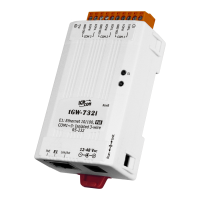
Do you have a question about the ICP DAS USA tGW-700 Series and is the answer not in the manual?
| Model | tGW-700 Series |
|---|---|
| Manufacturer | ICP DAS USA |
| Type | Gateway |
| Communication Protocols | Modbus TCP, Modbus RTU |
| Operating Temperature | -25°C to +75°C |
Lists the key capabilities and functionalities of the tGW-700/GW-2200 series modules.
Outlines the typical use cases and industries for the gateway modules.
Explains the benefits and role of Ethernet in industrial communication networks.
Describes the use of a web server for easy configuration and management of the devices.
Details the technical specifications, including CPU, interface, power, and environmental parameters.
Illustrates the physical layout and components of the tGW-700 and GW-2200 series modules.
Provides detailed physical dimensions for various module models and cables.
Details the terminal pin configurations for different serial COM ports on various models.
Offers guidance on proper wiring for serial communication interfaces.
Guides users on establishing physical connections for power and host computer.
Explains how to configure IP addresses and network parameters using the eSearch Utility.
Details how to connect the gateway to serial Modbus devices.
Provides steps for configuring serial port settings via the web interface.
Describes the process of performing a self-test to verify module operation.
Guides users on establishing physical connections for power and host computer using IPv6.
Explains how to configure network settings for IPv6 connectivity.
Details how to connect the gateway to serial Modbus devices for IPv6 operation.
Provides steps for configuring serial port settings via the web interface for IPv6.
Describes the process of performing a self-test for IPv6 operation.
Step-by-step guide on accessing the device's web interface for configuration.
Overview of the main status and information displayed on the web interface's home page.
Configuration options for static or dynamic IP addressing and IPv6 settings.
Configuration of Ethernet speed, HTTP port, alias, timeouts, and UDP settings.
Settings for Modbus protocol exceptions, CRC checks, and timeouts.
Procedure to reset all device settings to their original factory default settings.
Instructions for updating the device firmware over an Ethernet connection.
Page for configuring serial port parameters like baud rate, data format, and protocols.
Configuration of IP filter lists to restrict network access to the device.
Displays current status and statistics of serial port connections.
Options for changing the device's web interface login password.
Procedure to log out of the web interface and return to the login screen.
Demonstrates the gateway's function in converting Modbus TCP to RTU/ASCII.
Explains how Net ID is used for addressing slave devices in Modbus TCP requests.
Illustrates creating serial-to-serial connections over Ethernet using the gateway.
Shows how the gateway acts as a TCP client to connect to Modbus TCP slave devices.
Details the structure of Modbus/TCP and RTU messages, including headers and data fields.
Explains the various error codes returned by Modbus devices during communication.
Step-by-step guide to reset the web password and restore factory default settings.
